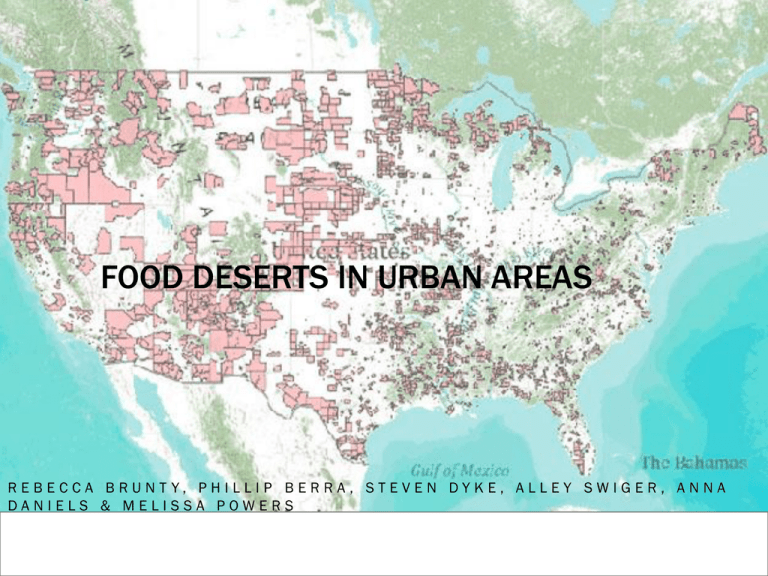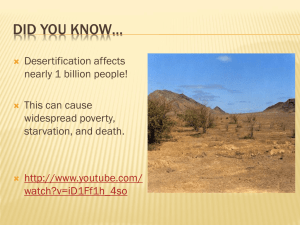Food Deserts in Urban Areas
advertisement

FOOD DESERTS IN URBAN AREAS REBECCA BRUNT Y, PHILLIP BERRA , STEVEN DYKE, ALLEY SWIGER , ANNA DANIELS & MELISSA POWERS WHAT DOES IT MEAN TO HAVE A HEALTHY COMMUNITY? WHY IS THIS IMPORTANT? Food policy consists of setting goals for the sectors of the food system. Doisy College of Health Sciences Saint Louis University Food System and the Food Cycle A food system can be judged by whether it: is technically efficient in social prices; supports higher standards of education; offers security; is allocatively efficient in enables people to have social prices; status; reduces vulnerability; leads to increased consumption by the poor; is good for environmental sustainability; enables people to have dignity; leads to increased asset- enables people to have holding by the poor; rights; promotes gender equality; is good for health; promotes equality in general; enables people to have influence; is good for nutrition; Doisy College of Health Sciences Saint Louis University promotes social inclusion Category Food Policy “Old” Food Policy “New” Population Mostly rural Mostly urban Supply chains Short – small number of food miles Long – large number of food miles Typical food preparation Mostly food cooked at home High proportion of pre-prepared meals, food eaten out Packaging Low High Food bought in Local stalls or shops, open markets Supermarkets Food safety issues Pesticide poisoning of field workers Toxins associated with poor storage Pesticide residues in food adulteration Bio-safety issues in processed foods (salmonella, listeriosis) Nutrition problems Under-nutrition Chronic dietary diseases (obesity, heart disease, diabetes) Nutrient issues Micronutrients Fat and Sugar Food-insecure ‘Peasants’ Urban and rural poor Remedy for household food shortage Safety nets, food-based relief Social protection, income transfers Fora for food policy Ministries of agriculture, relief/rehabilitation, health Ministries of trade & industry, consumer affairs Food activist groups, NGOs Focus of food policy Agricultural technology, supplementary feeding, food for work Competition and rent-seeking in the value chain, waste management, advertising, health education, food safety Doisy College of Health Sciences Saint Louis University WHAT IS A FOOD DESERT? Food Desert: FOOD DESERT DEFINITION To qualify as a "low-income community”, a census tract must have either: 1) a poverty rate of 20 percent or higher, OR 2) a median family income at or below 80 percent of the area's median family income; To qualify as a "low-access community”, at least 500 people and/or at least 33 percent of the census tract's population must reside more than one mile from a supermarket or large grocery store (for rural census tracts, the distance is more than 10 miles). RELATIONSHIP BETWEEN DIET AND HEALTH "Substantial current research emphasizes how urban food environments affect health particularly through the abundance of low-cost fast food, the death of supermarkets and fresh food and attendant effects on nutritional status and obesity.” –The Contribution of Urban Foodways to Health Disparities RELATIONSHIP BETWEEN DIET AND HEALTH -Conceptual Framework: multiple contributing factors to diet and health emphasized in a food desert environment. -Lack of access to nutritious food or the ability to exercise and practice a healthy lifestyle. -Correlation between access to supermarkets and less obesity. -Similar correlation with convenience stores and fast food: more fast food and convenience store, greater risk of obesity. -Increase in healthy options without a limitation of current food options will likely not have a significant effect. CONCERNS WITH FOOD DESERT AREAS Malnutrition -Obesity paradox – choosing cheaper foods to stretch budget Usually nutrient-poor and energy dense Results in overweight/obesity Increased risk of chronic diseases Diabetes, high blood pressure, heart disease, stroke, some cancers -Lacking key nutrients due to limited food choices -Limited options for physical activity WHY DOES IT MATTER? IS IT JUST? “The crowds of starving people—children, women, the elderly, immigrants, refugees, and unemployed—raise to us their cry of suffering. They implore us, hoping to be heard.”—Pope John Paul II --We have an ethical obligation to help others in need -Food and Agricultural Organization estimates that one billion people suffer from hunger with another one billion from undernourishment. SAINT LOUIS FOOD DESERTS SAINT LOUIS FOOD DESERTS 63108 63103 63110 63104 FOOD DESERT: 63104 FOOD DESERT: 63110 FOOD DESERT: 63103 63108—NON FOOD DESERT ST LOUIS CITY FOOD ENVIRONMENT Criteria Values Food Access Households, no car & >1 mile to store 3,498(2.35%) Food Access Households, Low Income & >1 mile to store 16,733 (4.87%) Child poverty rate 2010 40.7% (persistent child poverty county) Student free-school lunch eligibility 73.9% () Child food insecurity 2001-07 8.3% Household food insecurity 2008-10 15.8% SNAP benefits per capita 2008-2010 71% increase Farmers’ markets 6 (no change 2009-11) Grocery Stores/Convenience Stores/SNAP stores/WIC stores 115 () / 125 () /366 () / 19 () Doisy College of Health Sciences Saint Louis University ST. LOUIS DEMOGRAPHIC CHARACTERISTICS DEMOGRAPHIC CHARACTERISTICS • Racial Demographic • Age: • Majority African American • 0-4 years old: <10% • About 40% Caucasian • 15-24 years old: 12%-17% • 65+ years old: 10%-25% • Income • Food Desert Zip Codes: $25,000-$40,000 • Non Food Desert Zip Code:$54,000 • Education: • High School Graduation: 53%-62% ST. LOUIS MORTALITY RATES FOOD DESERT VS. NON FOOD DESERT MORTALITY • • Little variation overall Infant Mortality • All food desert zip codes had higher infant mortality rates than the non food desert zip code • This could come from a number of birth-related concerns • For example: 63110 (17th Ward) Birth-Related Conerns • Mid-high percent for: • Teen births • Out of wedlock births • Mothers using food stamps • Mothers with less than 12th grade education • Low birth weight infants 2,500 grams (5.5 #) or less • Highest rate for: • Infant mortality • Teen abortions OTHER ST. LOUIS HEALTH FACTORS FOOD DESERT VS. NON FOOD DESERT HEALTH FACTORS • Little variation, but still concerning issues • Concerning Health Factors • Food Bourne Illness • High Birth Weight • Influenza and Pneumonia • Low Fertility Rate VISIONING • System change keeps the focus on bigpicture thinking and is transformative beyond small actions. • Creation of a vision of what a healthy St. Louis Regional Foodshed would look like can help lay the pathway to the activities supportive of a regional food policy. Doisy College of Health Sciences Saint Louis University SOLUTIONS IN MOTION The Healthy Corner Store Project • A joint effort by the University of Missouri Extension, City of St. Louis, and the St. Louis Development Corporation aims to tackle the barriers that prohibit access to food retailers and nutritious, healthy foods in local food deserts. “The Old North St. Louis neighborhood was able to open a community-run grocery store but not every neighborhood in the city has the capacity to open grocery stores, nor should they. Another way to address the issue is to work with stores already in our neighborhoods to help people purchase the food necessary to live healthier lifestyles”--Kara Lubischer, community development specialist with UMSL Extension • Other Objectives: • Encouraging aldermanic interest • instituting grassroots marketing campaigns • Conducting surveys so researchers can identify what types of produce interest customers most. OTHER POSSIBLE SOLUTIONS 1. Taxation incentives Lower sales tax on fresh produce Goal: increase profit margins on fresh food Which would in turn encourage businesses to sell more fresh foods 2. Rebates From municipality to businesses based on the types of food they sold For example, if business sold a higher volume of healthy foods, they would receive a larger rebate 3. Financial Incentives Encourage businesses to have a particular business model For example: Save-A-Lot’s business model Exclusive brands: High-quality, low-priced private label assortment Fewer SKUs (stock keeping units) and low prices Neighborhood stores: Locating stores in diverse neighborhoods, hiring from within those communities and stocking product tailored to the neighborhood Shopping experience: Smaller stores average 15,000 sq. ft. and allow for a quick and easy shopping experience RESOURCES http://www.whyhunger.org/programs/fslc/topics/nutrition/glossary.html https://global.slu.edu/webapps/portal/frameset.jsp?tab_tab_group_id=_2_1&url=%2Fwebapps%2Fblackb oard%2Fexecute%2Flauncher%3Ftype%3DCourse%26id%3D_62905_1%26url%3D http://www.thenorthsider.com/2011/05/corner-store-sells-fresh-produce/ Movoto. Movato LLC, n.d. Web. 27 Nov. 2012. <http://www.movoto.com/>. Asch, David. "The Contribution of Urban Foodways to Health Disparities." N.p., 2010. Web. 27 Nov. 2012. <http://www.ncbi.nlm.nih.gov/pmc/articles/PMC2871079/>. Sodano, Angelo, and John Paul. "WORLD HUNGER A CHALLENGE FOR ALL: DEVELOPMENT IN SOLIDARITY." N.p., 1979. Web. 27 Nov. 2012. https://global.slu.edu/webapps/portal/frameset.jsp?tab_tab_group_id=_2_1&url=%2Fwebapps%2Fbla ckboard%2Fexecute%2Flauncher%3Ftype%3DCourse%26id%3D_62905_1%26url%3D Sundve, Stacy M., and David A. Harvey. "Public Health Understanding Our Needs." (2007): n. pag. Print.











